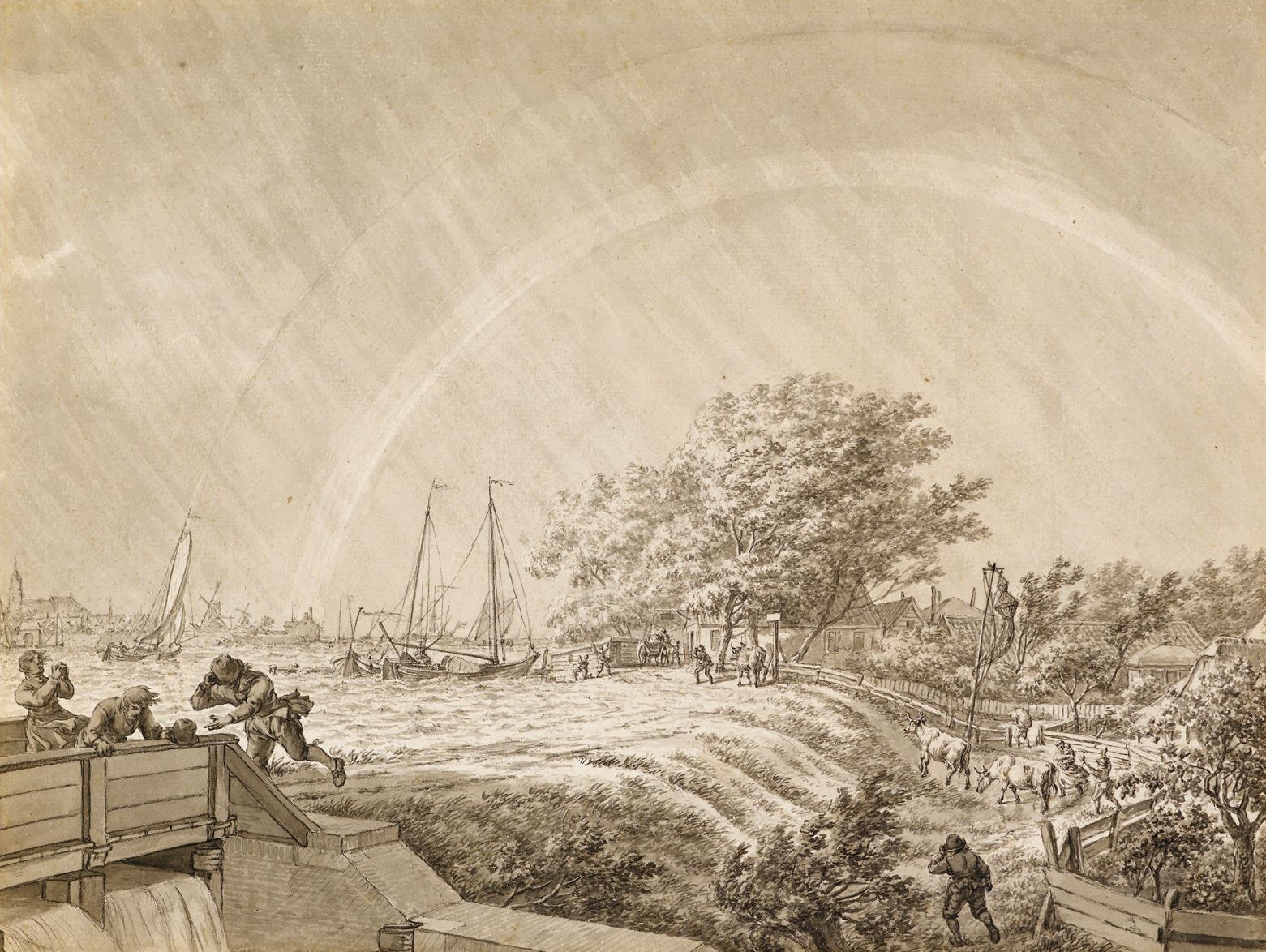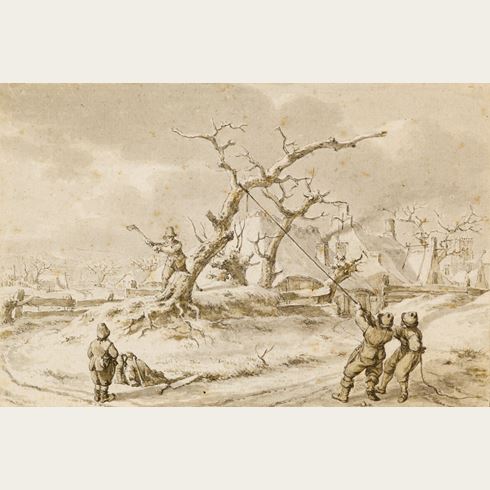Jacob CATS
(Altona 1741 - Amsterdam 1799)
Autumn Landscape with a Rainbow (Autumn, Afternoon and Water)
Sold
Pen and grey ink and grey wash, with framing lines in brown ink.
Signed and dated J. Cats fect 1797, numbered 726 and faintly inscribed Herfst Namiddag Waater on the verso.
Further inscribed (by Staring) Adv.(?) W. H. Staring....?? / Kerstmis 1931 on the verso.
308 x 410 mm. (12 1/8 x 16 1/8 in.)
Signed and dated J. Cats fect 1797, numbered 726 and faintly inscribed Herfst Namiddag Waater on the verso.
Further inscribed (by Staring) Adv.(?) W. H. Staring....?? / Kerstmis 1931 on the verso.
308 x 410 mm. (12 1/8 x 16 1/8 in.)
The present sheet is a preparatory study for a large finished watercolour by Cats, of similar dimensions, which is today in the Rijksmuseum in Amsterdam. The Rijksmuseum watercolour is signed, dated and inscribed in the same way as the present sheet, and also bears the inscription ‘September, October, November’.
The Rijksmuseum drawing is one of a series of four superb watercolours depicting the seasons, and also showing the four quarters of the day and the four elements, which were commissioned from the artist for 600 guilders by the collector Jan de Groot in 1797. Not long after Cats' death, this series of drawings was already acknowledged to be his masterpiece as a draughtsman. After De Groot’s death the series of four watercolours was acquired at auction in 1804 by the art dealer Christiaan Josi for 1,000 guilders, and eventually entered the collection of the Rijksmuseum in 1992.
The present sheet, as the artist’s inscription on the verso confirms, depicts Autumn, Afternoon and Water. The number 726 on the verso of the sheet is part of a numbering system used by Cats to keep his working drawings in order. Drawings bearing the numbers 714 and 728 are in the collection of the Amsterdam Historisch Museum in Amsterdam.
The Rijksmuseum drawing is one of a series of four superb watercolours depicting the seasons, and also showing the four quarters of the day and the four elements, which were commissioned from the artist for 600 guilders by the collector Jan de Groot in 1797. Not long after Cats' death, this series of drawings was already acknowledged to be his masterpiece as a draughtsman. After De Groot’s death the series of four watercolours was acquired at auction in 1804 by the art dealer Christiaan Josi for 1,000 guilders, and eventually entered the collection of the Rijksmuseum in 1992.
The present sheet, as the artist’s inscription on the verso confirms, depicts Autumn, Afternoon and Water. The number 726 on the verso of the sheet is part of a numbering system used by Cats to keep his working drawings in order. Drawings bearing the numbers 714 and 728 are in the collection of the Amsterdam Historisch Museum in Amsterdam.
One of the finest draughtsmen working in Holland in the second half of the 18th century, Jacob Cats is best known for the highly finished, atmospheric landscape drawings he produced as independent works of art for sale to collectors. He made sketching tours throughout the countryside but, since he often suffered from arthritis, seems to have only rarely actually worked outdoors. Blessed with a photographic memory, he would be able to integrate the views he saw in nature into realistic landscape drawings once he was back in the studio; indeed, he often noted, in an inscription on the reverse of a drawing, when it was done from memory. Cats numbered most of his drawings done in this way, so as to be able to refer to them in his studio when producing highly finished versions in pen and ink and watercolour. One 19th century scholar noted, however, that some collectors preferred the artist’s less finished drawings. As Adriaan van der Willigen wrote of Cats, ‘many of his Drawings are worked over quite extensively, indeed in the opinion of some this detailing is seen as excessive, working to the detriment of the Masterly treatment, while the work has been termed ‘sombre’ by some. This is the case in many of his coloured Drawings, for which reason his sketchy and less worked-up drawings are generally preferred by the true connoisseurs.’
Provenance
W. H. Staring, Kasteel Crabbehoff, Dordrecht, in 1931 (according to an inscription on the verso).
Literature
Wiepke Loos, Robert-Jan te Rijdt and Marjan van Heteren, On Country Roads and Fields: The depiction of the 18th- and 19th-century landscape, exhibition catalogue, Amsterdam, Rijksmuseum, 1997-1998, p.168, under no.24 (entry by Robert-Jan te Rijdt).





